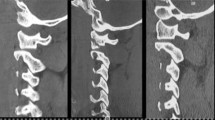Abstract
Purpose
Traumatic ligament injuries of the craniovertebral junction, either isolated or associated with bone avulsion or fracture, often lead to death. These injuries are rare and underrated but are increasingly seen in emergency departments due to the improvement in initial on-scene management of accidents. Vertical atlantoaxial dislocation (AAD) is a specific lesion that was barely reported. Based on our experience, our goal was to systematically investigate the prevalence and prognosis of traumatic vertical AAD and discuss its management.
Methods
All cervical CT scans performed at our institution between 2006 and 2010 for cervical trauma in adults were retrospectively reviewed. Based on the measurement of lateral mass index (LMI), defined as the gap between C1 and C2 articular facets, we identified three cases of traumatic vertical AAD in 300 CT scans. Their medical records were investigated.
Results
The incidence of vertical AAD was 1 % in the exposed population. One case was an isolated vertical AAD and two were associated with a type II odontoid fracture. We report the first case in the literature of unilateral vertical AAD. Two patients died rapidly; the survivor was treated with occipitocervical fixation. Specific maneuvers were used for immobilization and reduction.
Conclusions
This study found a not insignificant incidence of vertical AAD and a high lethality rate. LMI appears to be a relevant radiological criterion for this diagnosis, for which traction is contraindicated. Associated neurological or vascular damage should be suspected and investigated. In our experience, spinal surgical fixation is required because of major instability.





Similar content being viewed by others
References
Bohlman HH (1979) Acute fractures and dislocations of the cervical spine. An analysis of three hundred hospitalized patients and review of the literature. J Bone Joint Surg Am 61(8):1119–1142
Davis D, Bohlman H, Walker AE, Fisher R, Robinson R (1971) The pathological findings in fatal craniospinal injuries. J Neurosurg 34(5):603–613
Alker GJ Jr, Oh YS, Leslie EV (1978) High cervical spine and craniocervical junction injuries in fatal traffic accidents: a radiological study. Orthop Clin North Am 9(4):1003–1010
Dickman CA, Papadopoulos SM, Sonntag VK, Spetzler RF, Rekate HL, Drabier J (1993) Traumatic occipitoatlantal dislocations. J Spinal Disord 6(4):300–313
Yüksel KZ, Yüksel M, Gonzalez LF, Baek S, Heiserman JE, Sonntag VKH et al (2008) Occipitocervical vertical distraction injuries: anatomical biomechanical, and 3-tesla magnetic resonance imaging investigation. Spine 33(19):2066–2073
Yin Q, Ai F, Zhang K, Chang Y, Xia H, Wu Z et al (2005) Irreducible anterior atlantoaxial dislocation: one-stage treatment with a transoral atlantoaxial reduction plate fixation and fusion. Report of 5 cases and review of the literature. Spine 30(13):E375–E381
Jamshidi S, Dennis MW, Azzam C, Karim N (1983) Traumatic posterior atlantoaxial dislocation without neurological deficit: case report. Neurosurgery 12(2):211–213
Wong DA, Mack RP, Craigmile TK (1991) Traumatic atlantoaxial dislocation without fracture of the odontoid. Spine 16(5):587–589
Neumann U, Urbanski H, Riedel K (2003) Posterior atlantoaxial dislocation without fracture of the odontoid. A case report. J Bone Joint Surg Am 85-A(7):1343–1346
Nakamura T, Ishikawa K, Matsubara S, Okajima K (1991) Lateral atlantoaxial dislocation. Spine 16(2):245–247
Weiner BK, Brower RS (1997) Traumatic vertical atlantoaxial instability in a case of atlanto-occipital coalition. Spine 22(9):1033–1035
Ramaré S, Lazennec JY, Camelot C, Saillant G, Hansen S, Trabelsi R (1999) Vertical atlantoaxial dislocation. Eur Spine J 8(3):241–243
Payer M, Wetzel S, Kelekis A, Jenny B (2005) Traumatic vertical atlantoaxial dislocation. J Clin Neurosci 12(6):704–706
Spoor AB, Diekerhof CH, Bonnet M, Oner FC (2008) Traumatic complex dislocation of the atlanto-axial joint with odontoid and C2 superior articular facet fracture. Spine 33(19):E708–E711
Botelho RV, de Souza Palma AM, Abgussen CM, Fontoura EA (2000) Traumatic vertical atlantoaxial instability: the risk associated with skull traction. Case report and literature review. Eur Spine J 9(5):430–433
Hensinger RN (1986) Osseous anomalies of the craniovertebral junction. Spine 11(4):323–333
Carroll EA, Gordon B, Sweeney CA, Joy S, Connolly PJ (2001) Traumatic atlantoaxial distraction injury: a case report. Spine 26(4):454–457
Przybylski GJ, Welch WC (1996) Longitudinal atlantoaxial dislocation with type III odontoid fracture. Case report and review of the literature. J Neurosurg 84(4):666–670
Kirkpatrick JS, Sheils T, Theiss SM (2004) Type-III dens fracture with distraction: an unstable injury. A report of three cases. J Bone Joint Surg Am 86-A(11):2514–2518
Jea A, Tatsui C, Farhat H, Vanni S, Levi AD (2006) Vertically unstable type III odontoid fractures: case report. Neurosurgery 58(4):E797 (discussion: E797)
Pang D (2010) Atlantoaxial rotatory fixation. Neurosurgery 66(3 Suppl):161–183
Gonzalez LF, Fiorella D, Crawford NR, Wallace RC, Feiz-Erfan I, Drumm D et al (2004) Vertical atlantoaxial distraction injuries: radiological criteria and clinical implications. J Neurosurg Spine 1(3):273–280
Ranawat CS, O’Leary P, Pellicci P, Tsairis P, Marchisello P, Dorr L (1979) Cervical spine fusion in rheumatoid arthritis. J Bone Joint Surg Am 61(7):1003–1010
Kulkarni AG, Goel AH (2008) Vertical atlantoaxial index: a new craniovertebral radiographic index. J Spinal Disord Tech 21(1):4–10
Rowe F (2011) Prevalence of ocular motor cranial nerve palsy and associations following stroke. Eye (Lond) 25(7):881–887
Pinches E, Thompson D, Noordeen H, Liasis A, Nischal KK (2004) Fourth and sixth cranial nerve injury after halo traction in children: a report of two cases. J AAPOS 8(6):580–585
Schneider RC, Johnson FD (1971) Bilateral traumatic abducens palsy. A mechanism of injury suggested by the study of associated cervical spine fractures. J Neurosurg 34(1):33–37
Takagi H, Miyasaka Y, Kuramae T, Ohwada T, Tsunoda M (1976) Bilateral traumatic abducens nerve palsy without skull fracture or intracranial hematoma-a report of 3 cases and consideration of the mechanism of injury (author’s transl). No Shinkei Geka 4(10):963–969
Sam B, Ozveren MF, Akdemir I, Topsakal C, Cobanoglu B, Baydar CL et al (2004) The mechanism of injury of the abducens nerve in severe head trauma: a postmortem study. Forensic Sci Int 140(1):25–32
Conflict of interest
None.
Author information
Authors and Affiliations
Corresponding author
Rights and permissions
About this article
Cite this article
Pissonnier, M.L., Lazennec, J.Y., Renoux, J. et al. Trauma of the upper cervical spine: focus on vertical atlantoaxial dislocation. Eur Spine J 22, 2167–2175 (2013). https://doi.org/10.1007/s00586-013-2841-2
Received:
Revised:
Accepted:
Published:
Issue Date:
DOI: https://doi.org/10.1007/s00586-013-2841-2




